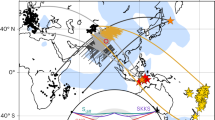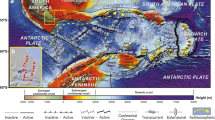Abstract
Based on the high-resolution body wave tomographic image and relevant geophysical data, we calculated the form and the vertical and tangential velocities of mantle flow. We obtained the pattern of mantle convection for East Asia and the West Pacific. Some important results and understandings are gained from the images of the vertical velocity of mantle flow for East Asia and the West Pacific. There is an upwelling plume beneath East Asia and West Pacific, which is the earth’s deep origin for the huge rift valley there. We have especially outlined the tectonic features of the South China Sea, which is of the “工” type in the upper mantle shield type in the middle and divergent in the lower; the Siberian clod downwelling dives from the surface to near Core and mantle bounary (CMB), which is convergent in the upper mantle and divergent in the lower mantle; the Tethyan subduction region, centered in the Qinghai-Tibet plateau, is visible from 300 to 2 000 km, which is also convergent in the upper mantle and divergent in the lower mantle. The three regions of mantle convection beneath East Asia and the West Pacific are in accordance with the West Pacific, Ancient Asia and the Tethyan structure regions. The mantle upwelling originates from the core-mantle boundary and mostly occurs in the middle mantle and the lower part of the upper mantle. The velocities of the vertical mantle flow are about 1–4 cm per year and the tangential velocities are 1–10 cm per year. The mantle flow has an effect on controlling the movement of plates and the distributions of ocean ridges, subduction zones and collision zones. The mantle upwelling regions are clearly related with the locations of hotspots on the earth’s surface.
Similar content being viewed by others
References
Becker T W, Boschi L (2002). A comparison of tomography and geodynamic mantle model. Geochemistry Geophysics Geosystems, 3: 2001GC000168
Boschi L, Dziewonski A M (2000). Whole earth tomography from delay times of P, PcP, and PKP phases: Lateral heterogeneity in the outer core or radial anisotropy in the mantle? J Geophys Res, 105: 13675–13696
Cai X L, Zhu J S, Cao J M, et al (2002a). Structure and dynamics of lithosphere and asthenosphere in the gigantic East Asian-West Pacific rift system. Geology in China, 29: 234–245 (in Chinese with English abstract)
Cai X L, Zhu J S, Cheng X Q (2002b). The characteristics and Implication of “工” Type Low Velocity Zone in astheosphere of South China Sea. Annual of the Chinese Geophysical Society, 247-247
de Mets C R, Gordon R G (1990). Current plate motions. Geophys J Int, 101: 425–478
Forte A M (2000). Seismic-geodynamic constraints on mantle flow: Implications for layered convection, mantle viscosity, and seismic anisotropy in the deep mantle. Geophysical Monograph, 117: 3–36
Forte A M, Dziewonski A M (1993). Asthenospherical structure of the mantle, tectonic plate motions, non-hydrostatic geiod, and topography of the core-mantle boundary. Geophysical Monograph, 72: 135–166
Forte A M, Mitrovica J X (2001). Deep-mantle high-viscosity flow and thermochemical structure inferred from seismic and geodynamic data. Nature, 410: 1049–1056
Forte A M, Peltier W R (1987). Plate tectonics and aspherical earth structure: The importance of poloidal-toroidal coupling. J Geophys Res, 92: 3645–3679
Forte A M, Peltier W R (1991). Viscous flow models of global geophysical observables, 1 Forward problems. J Geophys Res, 96: 20131–20159
Fu R S, Huang J H (1993). Inversion of mantle convection model using several geophysical data. Chinese J Geophys, 36(3): 298–307 (in Chinese with English abstract)
Fu R S, Huang J H, Dong S Q, et al (2003). A new mantle convection model constrained by seismic tomography data. Chinese J Geophys, 46(6): 772–778 (in Chinese with English abstract)
Fu R S, Zheng Y, Chang Y H, et al (2001). Seismic tomography and the evolution of the earth’s mantle. Progress in Geophysics, 16(4): 85–95 (in Chinese with English abstract)
Hager B H (1984). Subducted slabs and the geiod: Constraints on mantle rheology and flow. J Geophys Res, 89: 6003–6015
Press W H, Flannery B P, Teukolsky S A, et al (1986). Numerical Recipes. Cambridge: Cambridge University Press
Shi Y L (2001). Advances in mantle convection study. Advance in Earth Sciences, 16(4): 496–500 (in Chinese with English abstract)
Ye Z R (1993). The numerical modelling of mantle convection and its relationship to surface observations. Chinese J Geophys, 36(1): 27–36 (in Chinese with English abstract)
Ye Z R, Hager B H (2001). Generation and distribution of global heat flow. Chinese J Geophys, 44(2): 171–179 (in Chinese with English abstract)
Zhu J S (2000). Structure of lower mantle and core-mantle boundary region and its geodynamics. Advance in Earth Sciences, 15(2): 139–142 (in Chinese with English abstract)
Zhu J S, Cao J M, Cai X L (2002). High resolution surface wave tomography in East Asia and West Pacific marginal sea. Chinese J Geophys, 45(5): 679–698 (in Chinese with English abstract)
Author information
Authors and Affiliations
Corresponding author
Additional information
Translated from Geology in China, 2006, 33(4): 896–905 [译自: 中国地质]
Rights and permissions
About this article
Cite this article
Cheng, X., Zhu, J. & Cai, X. Vertical velocity of mantle flow of East Asia and adjacent areas. Front. Earth Sci. China 1, 172–180 (2007). https://doi.org/10.1007/s11707-007-0022-5
Issue Date:
DOI: https://doi.org/10.1007/s11707-007-0022-5




